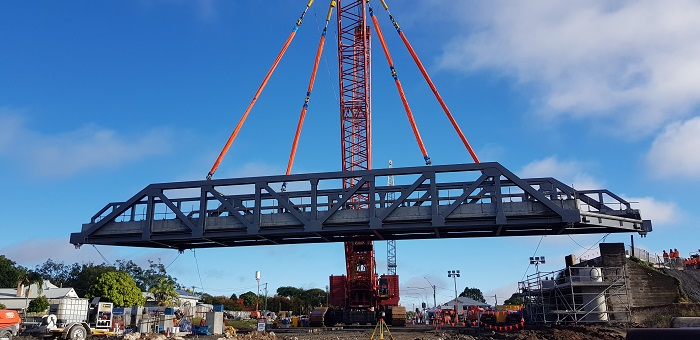conference speakers
HICKSON ROAD ARCH BRIDGES, SYDNEY – STRUCTURAL ANALYSIS FOR PREDICTED GROUND MOVEMENTS
The three arch bridges that cross Hickson Road at Millers Point in Sydney’s CBD represent an early application of reinforced concrete for large span bridges in NSW.
The bridges were built by the Sydney Harbour Trust and are classified as Monier arches. At the time of their construction, 1910 to 1914, they were noted by Sydney’s Daily Telegraph newspaper as the “largest reinforced concrete bridges in New South Wales”.
Due to predicted ground movements from nearby tunnel and cavern excavation work for the Sydney Metro rapid transit system, the arch bridges were structurally analysed to check their capacity to withstand the anticipated horizontal and vertical movements.
The following paper describes the history of the distinctive Hickson Road arch bridges, together with details of the structural analysis work undertaken. Also, a brief outline is provided on the history of Monier arch bridges in NSW.


Ken Maxwell
Technical Director, Bridges, Arcadis
Ken Maxwell BE Civil (Hons 1) MES FIEAust has designed over 85 bridges and has been involved in the, assessment, concept design and detailed design of road and railway bridges for over 30 years. Ken is a Fellow of and a Chartered Professional Engineer (Civil and Structural) of The Institution of Engineers, Australia, and a member of the International Association for Bridge and Structural Engineering. He is accredited with Transport for NSW as a Subject Matter Expert (Structural), ARTC as Designer/Verifier/Approver of bridge design projects, and to undertake Third Party Works Independent Design Review of bridge design projects on behalf of John Holland Rail.
TRACING LOAD PATH IN A CONCRETE TRUSS BRIDGE AND DEVELOPING DESIGN DETAILS FOR A TYPICAL NODE: REFERENCE TO THE FIU PEDESTRIAN BRIDGE THAT COLLAPSED IN MARCH 2018
The focus of this paper is to discuss design requirements for a typical node of a concrete truss bridge, to achieve robust, stiff and durable performance in an elegant pedestrian crossing.
Geometrical configuration at a node demands the skilful art of balancing the demand of aesthetic appearance, understanding the mechanism of how loads are transferred between members, applying appropriate parameters on the theories of engineering science and accommodating the necessary reinforcement inside the concrete surface.
The building industry should not discourage adopting innovative solutions consisting of a concrete truss in new bridge projects, influenced by the collapse of a pedestrian bridge at the Florida International University in March 2018. Good design can be developed to build elegant bridges successfully.
Hari Pokharel
Associate Technical Director, Arcadis Asia Pacific
Hari Pokharel has master’s degree in structural engineering and more than 30 years industry experience in design, construction and design management of major infrastructure projects in Australia and Asia, mostly related to bridges and heavy structures. He is a chartered professional engineer and member of the Engineers Australia and the American Society of Civil Engineers. Hari is currently working as an Associate Technical Director in Arcadis, Sydney office.
BRIDGE MANAGEMENT – GUIDE TO USING STRUCTURAL HEALTH MONITORING
The disciplines of bridge management and Structural Health Monitoring (SHM) are both undergoing rapid development.
This paper summarises some of the key trends in both disciplines, and explores the value proposition for the use of SHM in bridge management currently and in the foreseeable future.
Examples will be discussed to illustrate both poor value propositions and good value propositions for SMH supporting bridge management.
Guidance will be provided suitable workflows to engage structural health monitoring to deliver value for bridge management. Some of the key technology advances (in both fields) will also be discussed to illustrate emerging opportunities for the bridge sector, with a focus on local government application.
Dr Tim Heldt
Chief Technology Leader, ARRB
Dr.Tim Heldt has over 30 years of experience, and currently leads the Australian Road Research Board (ARRB) structures team to deliver quality consulting and research outcomes in the field of structures, asset management services, and technical evaluation. Tim has specialist knowledge and skills in life extension and risk management using ASISO13822. Coupled with his extensive experience in strategic asset management, due diligence and corporate review of strategy (civil and structures) and structural assessment through testing, Tim has the experience to quantify structural risk.
Joshua Seskis
Senior Professional Leader, ARRB
Joshua Seskis is a lead inspecting engineer who is currently responsible for Level 1 and 2 inspection workshop delivery and managing complex inspections for the team. He has previously conducted inspections on structures, which included provisional accreditation, as part of handover inspections conducted for the Moreton Bay Rail Link, Brisbane. He is also responsible for many of the Level 3 inspections conducted by ARRB. Joshua has also had extensive experience working on project related to heavy vehicle assessments and assessment frameworks.